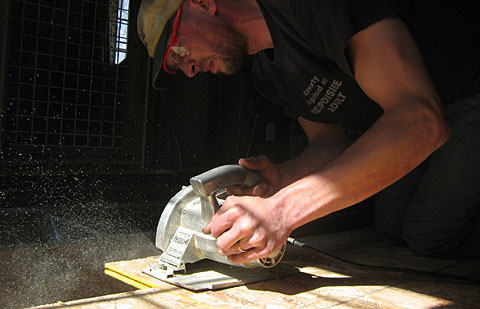Now Get Rid of Squeaky Floor with Plywood Screws
Plywood screws, which are also known as chipboard screws are self-tapping screws, featuring thin shaft and coarse threads. These fasteners are made up of either wood dust or wood chips and resin, and as the name suggests, these screws are mainly in plywood and other soft wood surfaces.
These rivets are made to clinch this composite surface, so as to withstand loosening. The screws firmly hold either two plywood or any chipboard to other materials, say natural wood.
Apart from wooden works, these screws are highly recommended for squeaky floors as well. Recently one of our esteemed clients faced an issue with pressboard sub-flooring in his 20 years old house. While his upstairs flooring was creaking under the carpet, the downstairs floors jolt the entire house whenever stepped on promptly.
His main concern was to stop those high-pitched annoying sound and if he should go for another layer of plywood over the existing flooring? He was also interested in replacing the entire floor.

So, this is what we had suggested him. Read on!
Instead of spending huge bucks in replacing the entire flooring, you can always go for an additional layer of plywood, which will definitely resolve all those issues. We highly recommend you to go for thicker material, as thicker the size would be, the degree of sound transmission would be reduced to more extent.
And yes, it’s always possible to fasten the existing wooden surface with the new layering. You’ll have to mark out the old nailing patterns, which should be in a gap of minimum 16 inches. Our aim should be enabling every new fastener with a supporting beam. By doing this, the squeaks will be reduced to a great extent and will even laminate properly the new layers along-with the base.
The plywood screws are the most ideal supplies required for fastening and you can even go for gluing, thereby strengthening the grip even more.

In the meanwhile, do not forget about the sap, which pulls this surface up. So, better fasten it with those screws.
And do not try compromising with the quality of the screws, as this is definitely not a place to think about cost-cutting. So purchase the plywood screws in ample quantity and insert screw at every 4-6 inches of gap at the seams and at every 6-8 inches of gap in the field.
This is indeed an effective method, giving away long lasting results.

If your plywood is of 5-8 inches thick then you should consider those screws, which are at least 2 and 1/2 inches long, so that they can get a nice grip. However be warned that you don’t have any radiant heating line or plumbing beneath this surface.
We suggest you to go for an half inch plywood for the layering and you can even bowl over the seams from the existing surface. You can go cheap on the facings for the plywood to save from the recent hike in their pricing. For instance, you can go for CCX PTS, which exactly works as the ‘A’ grade material or you can even opt for OSB, which works well under the carpet.
The rooms with carpets need a little adjustment, as you would have to manage with the closets and swing doors for proper installation. You need to build a carpet shelf by raising the level of the carpeted areas.
But the major problem arises in areas, where you’re thinking of installing vinyl or linoleum flooring. For this, you’ll need a third layer of chipboard or particle board and so also the have to determine the size and thickness of plywood screws.
Not to mention, stairs are another nightmare. You can easily face trip hazards and in order to prevent this, you should confirm that the building code should have a minimum gap of at least 3-8 inches between the stairs, but the height should not exceed above 8.

Leave a Reply